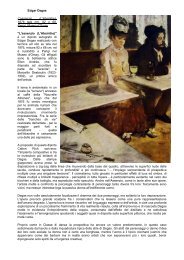I templi preistorici di Stonehenge e Avebury - The preistoric temples ...
I templi preistorici di Stonehenge e Avebury - The preistoric temples ...
I templi preistorici di Stonehenge e Avebury - The preistoric temples ...
You also want an ePaper? Increase the reach of your titles
YUMPU automatically turns print PDFs into web optimized ePapers that Google loves.
I <strong>templi</strong><br />
<strong><strong>preistoric</strong>i</strong> <strong>di</strong><br />
<strong>Stonehenge</strong><br />
e <strong>Avebury</strong><br />
a cura <strong>di</strong> /by Dr Daniele Vilasco<br />
<strong>The</strong> prehistoric<br />
<strong>temples</strong> of<br />
<strong>Stonehenge</strong><br />
and <strong>Avebury</strong>
Piantina <strong>di</strong> <strong>Stonehenge</strong> con le varie fasi costruttive C’è stato un tempo, millenni fa, in cui il<br />
nostro continente era un’unica grande<br />
realtà, dalle coste atlantiche a quelle<br />
del Mar Nero. Di quella che fu la prima Europa<br />
unita restano gigantesche testimonianze <strong>di</strong><br />
pietra, i famosi monumenti megalitici che da<br />
allora non hanno mai smesso <strong>di</strong> colpire la fantasia<br />
degli uomini. Queste possenti strutture<br />
cominciarono ad essere erette a partire dal<br />
4500 a.C. lungo una larga fascia che comprende<br />
isole britanniche, Olanda, Danimarca e<br />
Germania del nord, penisola iberica, Francia,<br />
Italia, Bulgaria e Georgia.<br />
Tutta quest’area presenta numerose attestazioni<br />
<strong>di</strong> camere funerarie realizzate con gran<strong>di</strong><br />
blocchi <strong>di</strong> pietra coperti da lastroni (dolmen),<br />
pietre infisse verticalmente nel terreno, da<br />
sole o in lunghe file (menhir) e circoli <strong>di</strong> pietre<br />
all’interno dei quali si svolgevano riti religiosi<br />
(cromlech).<br />
Plan of <strong>Stonehenge</strong> with the various stages of construction Costruiti in quelli che ai nostri occhi appaiono<br />
come luoghi cupi e solitari, ingran<strong>di</strong>ti e risistemati<br />
più volte, questi monumenti vennero realizzati secondo rituali e scopi che restano<br />
ignoti e misteriosi. Alcuni <strong>di</strong> essi tuttavia fanno chiaramente riferimento a fenomeni<br />
legati al ciclo delle stagioni, nonché al sorgere e al tramontare del Sole, della Luna<br />
e anche <strong>di</strong> importanti stelle e costellazioni.<br />
Per le popolazioni <strong>preistoric</strong>he del tempo, ancora <strong>di</strong>vise tra una ru<strong>di</strong>mentale agricoltura<br />
e l’abituale allevamento e perciò semi-noma<strong>di</strong>, questi giganti <strong>di</strong> pietra furono in<strong>di</strong>spensabili<br />
punti <strong>di</strong> riferimento sul territorio e importanti segnali, per sé e per le altre<br />
tribù, della progressiva conquista <strong>di</strong> quel mondo ignoto e selvaggio che fino ad allora<br />
era stato l’Europa.<br />
I due più importanti <strong>templi</strong> <strong><strong>preistoric</strong>i</strong> della Gran Bretagna, <strong>Stonehenge</strong> e <strong>Avebury</strong>,<br />
sorgono ad esempio ad una <strong>di</strong>stanza relativamente breve l’uno dall’altro, solo ventotto<br />
chilometri, in quella ridente regione del sud dell’Inghilterra che è la pianura intorno<br />
a Salisbury, un paesaggio verdeggiante appena movimentato da piccole colline gessose.<br />
Durante il neolitico la zona fu il fulcro <strong>di</strong> un vasto reticolo <strong>di</strong> vie commerciali, le<br />
quali convergevano qui attraverso i crinali privi <strong>di</strong> boschi che ancora attraversano<br />
tutta l’Inghilterra meri<strong>di</strong>onale. Grazie ad essi si potevano infatti evitare le numerose<br />
valli paludose e impercorribili che allora solcavano l’Isola e lungo il loro percorso sono<br />
state rinvenute numerose testimonianze <strong>di</strong> commerci <strong>di</strong> lunga <strong>di</strong>stanza, chiara testimonianza<br />
della loro importanza per le popolazioni primitive del tempo.<br />
Merci e uomini si spostavano soprattutto lungo la famosa Harroway, la via che da<br />
Dover giungeva fino a <strong>Stonehenge</strong>. Allora come oggi, lo stretto <strong>di</strong> Dover era infatti la<br />
principale porta d’accesso all’isola dal continente, il che permette <strong>di</strong> capire più <strong>di</strong> ogni<br />
altro dato quale dovesse essere l’importanza del grande tempio astronomico <strong>di</strong><br />
Vista da est, <strong>Stonehenge</strong> si staglia contro<br />
il cielo del tramonto<br />
Seen from the east, <strong>Stonehenge</strong> stands out<br />
against the sunset sky<br />
<strong>Stonehenge</strong>, posto al termine della più vitale<br />
tra le “piste” commerciali dell’Inghilterra<br />
<strong>preistoric</strong>a. La <strong>Stonehenge</strong> attuale è il frutto<br />
del progressivo accumulo <strong>di</strong> fasi costruttive<br />
<strong>di</strong>verse, in una lunga sovrapposizione cominciata<br />
a partire dal 3000 a.C. circa.<br />
A questa data risalgono infatti il fossato circolare<br />
e l’argine, all’interno dei quali dovevano<br />
probabilmente esistere alcune strutture in<br />
legno, realizzate con pali.<br />
Così sembrerebbe in<strong>di</strong>care la scoperta, appena<br />
all’interno del terrapieno, <strong>di</strong> ben 56 buche<br />
<strong>di</strong> palo <strong>di</strong>sposte a formare un grande circolo.<br />
Esisteva un unico ingresso al complesso,<br />
costituito da un viale orientato verso nord-est,<br />
ovverosia lungo l’asse del tramonto nel solstizio<br />
d’inverno e dell’alba nel solstizio d’estate.<br />
Fu già in questa prima fase che la famosa<br />
Heel Stone, pesante ben trentacinque tonnellate,<br />
ed una seconda pietra, ora scomparsa
<strong>The</strong>re was a time, thousands of years ago, when our continent was a single<br />
great unit, from the Atlantic to the Black Sea coasts. Of what was the first<br />
United Europe there remain gigantic records in stone, the famous megalithic<br />
monuments which have never ceased to strike people’s imagination ever since.<br />
Erection of these imposing structures began from 4,500 BC onwards, along a wide<br />
band taking in the British Isles, Holland, Denmark and North Germany, the Iberian<br />
peninsula, France, Italy, Bulgaria and Georgia. All this area presents numerous<br />
examples of burial chambers made up of large stone blocks covered by slabs<br />
(dolmens), stones fixed vertically in the ground, alone or in long rows (menhirs) and<br />
stone circles within which religious rites were held (cromlechs).<br />
Built in what appear to our eyes as bleak, solitary sites, enlarged and rearranged<br />
several times, these monuments were created accor<strong>di</strong>ng to rituals and purposes that<br />
remain unknown and mysterious. Some of them, however, make a clear reference to<br />
phenomena relating to the cycle of the seasons, as well as the rising and setting of the<br />
Sun, the Moon and important stars and constellations.<br />
For the prehistoric peoples of the time, still <strong>di</strong>vided between ru<strong>di</strong>mentary agriculture<br />
and bree<strong>di</strong>ng of livestock, and therefore seminoma<strong>di</strong>c, these stone giants were in<strong>di</strong>spensable<br />
reference points on the land and important signs, for themselves and other<br />
tribes, of the gradual conquest of that unknown, wild world that Europe had been until<br />
then. <strong>The</strong> two most important prehistoric <strong>temples</strong> in Great Britain - <strong>Stonehenge</strong> and<br />
<strong>Avebury</strong> - stand a relatively short <strong>di</strong>stance<br />
apart, only twenty-eight kilometres, in that<br />
<strong>Stonehenge</strong> come appare oggi<br />
pleasant region of southern England known<br />
as Salisbury plain, a verdant countryside only<br />
just enlivened by small chalky hills.<br />
During the Neolithic age the area was the hub<br />
of a vast network of trade routes, which<br />
converged there along the unwooded ridges<br />
which still cross the whole of southern<br />
England. Thanks to these it was possible to<br />
avoid the many marshy, impassable valleys<br />
which ran across the island at that time and<br />
numerous records of long <strong>di</strong>stance trade have<br />
been found along their routes, as a clear<br />
witness to their importance to the primitive<br />
peoples of the time. Merchan<strong>di</strong>se and men<br />
moved especially along the famous Harroway,<br />
the road from Dover to <strong>Stonehenge</strong>.<br />
<strong>Stonehenge</strong> as it appears today<br />
<strong>The</strong>n as now, the strait of Dover was the main<br />
port of access to the island from the continent,<br />
which more than any other fact enables us to understand what must have been the<br />
importance of the great astronomical temple of <strong>Stonehenge</strong>, stan<strong>di</strong>ng at the end of the<br />
most vital trade route in prehistoric England.<br />
Present-day <strong>Stonehenge</strong> is the result of the gradual accumulation of <strong>di</strong>fferent stages of<br />
buil<strong>di</strong>ng, in a long superimposition which began from about 3000 BC.<br />
<strong>The</strong> circular <strong>di</strong>tch and the embankment date from those times and within these there<br />
were probably wooden structures built with stakes. This would seem to be in<strong>di</strong>cated by<br />
the structure, just inside the embankment, of as many as 56 stake holes arranged in a<br />
large circle. <strong>The</strong>re was a single entrance to the complex, consisting of an avenue<br />
running north-east, along the axis between sunset in the winter solstice and dawn in<br />
the summer solstice. Already at this early stage the famous Heel Stone, weighing no<br />
less than thirty-five tonnes, and a second stone which has <strong>di</strong>sappeared but was probably<br />
similar to the first, were laid at the sides of the sanctuary entrance, making it a<br />
monumental entrance. Probably the area within the three concentric circles formed by<br />
the <strong>di</strong>tch, the embankment and the circle of stakes was left free for the hol<strong>di</strong>ng of<br />
ceremonies of which we unfortunately know nothing. At a certain point, for reasons<br />
unknown to us, the area was abandoned, judging by the fin<strong>di</strong>ng of a large number of<br />
DIAMANTE Applicazioni & Tecnologia<br />
31
ma con ogni probabilità uguale alla prima, vennero infisse ai lati dell’ingresso del<br />
santuario, in modo da costituirne un ingresso monumentale.<br />
Probabilmente l’area all’interno dei tre cerchi concentrici formati dal fossato, dal<br />
terrapieno e dal cerchio <strong>di</strong> pali venne lasciata libera per lo svolgimento <strong>di</strong> cerimonie <strong>di</strong><br />
cui sfortunatamente non conosciamo nulla. Ad un certo punto, per cause che non<br />
conosciamo, l’area venne abbandonata, stando a quanto ci racconta il rinvenimento <strong>di</strong><br />
abbondanti gusci <strong>di</strong> lumache chiamate Zonitidae, abituali frequentatrici <strong>di</strong> prati incolti,<br />
non utilizzati neppure per il pascolo. Il monumento continuò ad essere usato esclusivamente<br />
come cimitero, come testimoniano le circa trenta cremazioni rinvenute nell’area<br />
delle buche <strong>di</strong> palo; in tutta la zona intorno ad esso inoltre cessò qualsiasi<br />
forma <strong>di</strong> agricoltura e <strong>di</strong> allevamento.<br />
La forza evocativa del luogo e dei suoi culti comunque sopravvisse all’oblio, dal<br />
momento che, con l’arrivo <strong>di</strong> nuove popolazioni, definite popolo delle Coppe, i culti<br />
nel santuario ripresero vigore. Questi nuovi abitanti,<br />
originari della valle del Reno, nell’o<strong>di</strong>erna<br />
Germania, giunsero in Inghilterra tra il 2500 e il<br />
2200 a.C., a seguito <strong>di</strong> un vero e proprio fenomeno<br />
<strong>di</strong> colonizzazione, in cerca <strong>di</strong> nuove terre da<br />
coltivare e <strong>di</strong> materiali rameosi.<br />
Con la loro venuta gli archeologi fanno tra<strong>di</strong>zionalmente<br />
iniziare l’Età del Bronzo sull’Isola.<br />
A partire dal 2100 a.C. <strong>Stonehenge</strong> conobbe<br />
quin<strong>di</strong> una nuova fase costruttiva, durante la<br />
quale il suo orientamento a nord-est venne fortemente<br />
enfatizzato dalla monumentalizzazione del<br />
Viale, che venne affiancato sui due lati da due<br />
argini, con relative trincee esterne, lunghi oltre<br />
cinquecento metri. L’ingresso stesso venne allargato<br />
e tutto il monumento venne riallineato<br />
secondo un asse spostato leggermente più a est,<br />
ovverosia a cinquanta gra<strong>di</strong> rispetto ai precedenti<br />
quarantuno. Lungo il grande argine circolare vennero<br />
infisse le quattro Pietre <strong>di</strong> Riferimento<br />
(Station Stones), le quali costituirono i vertici <strong>di</strong><br />
un rettangolo ideale che racchiudeva la vasta<br />
area centrale e appariva orientato secondo una<br />
complessa serie <strong>di</strong> dati astronomici.<br />
Stando alla ricostruzione attuale, infatti, i lati<br />
corti, paralleli al Viale e alla Heel Stone, erano<br />
orientati verso il punto in cui sorge il Sole durante<br />
il Solstizio d’Estate, mentre i lati lunghi trovavano<br />
la loro origine nelle posizioni estreme toccate<br />
dalla Luna al solstizio d’estate e a quello d’inverno.<br />
La sacralità <strong>di</strong> questo orientamento venne<br />
sancita dalla realizzazione, intorno a ciascuna<br />
delle quattro Pietre, <strong>di</strong> un argine e della corrispondente<br />
fossa circolare, chiaro segno della<br />
volontà <strong>di</strong> preservarle e isolarle all’interno del<br />
monumento. Fu in questo momento inoltre che<br />
comparvero per la prima volta le famose Pietre<br />
Azzurre, utilizzate per due modesti cerchi posti al centro del complesso, ciascuno dei<br />
quali con l’ingresso volto, ancora una volta, al Viale. Con ogni probabilità fu poi proprio<br />
in quest’epoca che venne tracciata la strada che collegava il santuario al fiume<br />
Avon, penultima tappa del lunghissimo viaggio, ben 360 chilometri, che le Blue<br />
Stones compivano dal Monte Prescelly fino a <strong>Stonehenge</strong>.<br />
Tuttavia solo a partire dal 2000-1900 a.C. <strong>Stonehenge</strong> assunse l’aspetto che ancora<br />
oggi colpisce con tanta forza la nostra immaginazione. Nell’arco <strong>di</strong> circa quattrocento<br />
anni il santuario <strong>di</strong>venne infatti una vera e propria selva <strong>di</strong> monoliti variamente <strong>di</strong>sposti<br />
e collegati tra loro, ancora una volta secondo uno schema circolare fortemente<br />
legato a complessi calcoli astronomici.<br />
Ad una prima fase risalgono non solo il famosissimo Ferro <strong>di</strong> Cavallo, composto da<br />
cinque coppie <strong>di</strong> giganteschi triliti, ma anche il cerchio <strong>di</strong> blocchi <strong>di</strong> arenaria collegati<br />
da architravi monolitici, chiamato Circolo Sarsen, che lo circonda. Le pietre con cui<br />
quest’ultimo venne realizzato provenivano a loro volta da lontano, dalle alture nei<br />
pressi <strong>di</strong> <strong>Avebury</strong>, a circa trentadue chilometri <strong>di</strong> <strong>di</strong>stanza.<br />
Il Ferro <strong>di</strong> Cavallo. Sulla sinistra, quanto rimane del trilite centrale, sormontato dal tenone.<br />
L’architrave abbattuta, <strong>di</strong> cui sono visibili le due mortase, giace davanti ad esso<br />
<strong>The</strong> Horseshoe. On the left, what remains of the central trilithon, surmounted by<br />
the tenon. <strong>The</strong> fallen architrave, with the two mortises visible, lies in front of them
shells of snails known as Zoniti<strong>di</strong>ae, which<br />
habitually frequent uncultivated areas not<br />
even used as pasture.<br />
<strong>The</strong> monument continued to be used<br />
exclusively as a cemetery, as witnessed by<br />
the thirty or so cremations <strong>di</strong>scovered in the<br />
area of the stake-holes. In ad<strong>di</strong>tion, all forms<br />
of agriculture and her<strong>di</strong>ng ceased throughout<br />
the surroun<strong>di</strong>ng area. However, the evocative<br />
force of the site and its cults survived oblivion<br />
because with the arrival of new peoples,<br />
known as the Bowls people, worship in the<br />
holy place revived.<br />
<strong>The</strong>se new inhabitants, originating from the<br />
Rhine valley in modern Germany, arrived in<br />
England between 2500 and 2200 BC, in a<br />
wave of colonization, looking for new land to<br />
cultivate and copper ores.<br />
Archaeologists tra<strong>di</strong>tionally date the Bronze<br />
Age in the island from their arrival.<br />
From 2100 BC onward <strong>Stonehenge</strong> thus saw a new phase of buil<strong>di</strong>ng, during which its<br />
north-east orientation was strongly emphasised by the monumentalization of the<br />
Avenue, which was flanked by two embankments, with relating external trenches, over<br />
five hundred metres long. <strong>The</strong> entrance itself was widened and the whole monument<br />
was realigned along an axis slightly more easterly in <strong>di</strong>rection, at 50° rather than the<br />
previous 41°. <strong>The</strong> four reference Station Stones were placed along the large circular<br />
embankment, forming the corners of an ideal rectangle which took in the wide central<br />
area and seems to have been oriented accor<strong>di</strong>ng to a complex series of astronomical<br />
data. Going by the present structure, the short sides, parallel to the Avenue and the<br />
Heel Stone, were oriented towards the point where the sun rises during the Summer<br />
Solstice, while the long sides had their origin in the extreme positions touched by the<br />
moon at the summer and winter solstices.<br />
<strong>The</strong> sacred nature of this orientation was sanctioned by the creation around each of<br />
the four Stones of an embankment with a correspon<strong>di</strong>ng circular trench, a clear sign of<br />
the desire to preserve them and isolate them within the monument. It was also at this<br />
time that the famous Blue Stones first appeared, used for two modest circles at the<br />
centre of the complex, each having its entrance once again facing the Avenue.<br />
In all probability it was precisely in this period that the road connecting the holy place<br />
to the river Avon was traced, the next to last<br />
stage of the very long 360-kilometres journey<br />
made by the Blue Stones from Mount<br />
Prescelly to <strong>Stonehenge</strong>.<br />
However, it was only from 2000-1900 BC that<br />
<strong>Stonehenge</strong> took on the appearance that still<br />
strikes our imagination so much today.<br />
Over about four hundred years the site<br />
became a forest of monoliths, variously arranged<br />
and connected, once again accor<strong>di</strong>ng to a<br />
circular scheme closely linked to complex<br />
astronomical calculations.<br />
From the first stage date not only the famous<br />
Horseshoe, made up of five pairs of gigantic<br />
trilithons, but also the circle of sandstone<br />
blocks connected by monolithic architraves,<br />
known as the Sarsen Circle, which surrounds<br />
it. <strong>The</strong> stones with which the latter was built<br />
came in turn from a long <strong>di</strong>stance, from the<br />
Tre pietre ancora in situ del Circolo Sarsen<br />
Three stones of the Sarsen Circle still in situ<br />
Veduta del Circolo Sarsen e delle Pietre Azzurre, molto più piccole,<br />
poste al suo interno<br />
View of the Sarsen Circle with the much smaller Blue Stones inside it<br />
DIAMANTE Applicazioni & Tecnologia<br />
33
Pianta <strong>di</strong> <strong>Avebury</strong><br />
Map of <strong>Avebury</strong><br />
Questo cerchio <strong>di</strong> arenarie, con la sua curva<br />
regolare e la perfezione degli incastri<br />
maschio-femmina che collegano architravi e<br />
pilastri nonostante la pendenza del terreno,<br />
non smette <strong>di</strong> stupire gli osservatori moderni<br />
e mostra con chiarezza estrema le incre<strong>di</strong>bili<br />
capacità tecniche raggiunte dalle<br />
popolazioni dell’Età del Bronzo.<br />
Intorno al 1550 a.C. il complesso conobbe<br />
ulteriori mo<strong>di</strong>fiche, per molti versi ancora<br />
misteriose. Innanzi tutto, una selva <strong>di</strong> pali<br />
lignei, <strong>di</strong>sposti su due cerchi concentrici,<br />
venne impiantata all’esterno del Circolo<br />
Sarsen: <strong>di</strong> essa rimangono solo le tracce<br />
delle numerosissime buche <strong>di</strong> palo, definite<br />
dagli archeologi come Cerchio Z e Cerchio Y.<br />
Inoltre le Pietre Azzurre impiantate nel<br />
periodo precedente vennero estratte dalle<br />
loro se<strong>di</strong> e risistemate, in armonia con i<br />
massi usati per il Circolo Sarsen, a formare<br />
un ovale all’interno del Ferro <strong>di</strong> Cavallo.<br />
Poco tempo dopo la <strong>di</strong>sposizione delle Blue<br />
Stones venne <strong>di</strong> nuovo mo<strong>di</strong>ficata e le<br />
pietre andarono a formare due <strong>di</strong>stinti raggruppamenti, un piccolo ferro <strong>di</strong> cavallo<br />
all’interno dell’omonimo e ben più imponente insieme <strong>di</strong> triliti e un nuovo ovale posto<br />
tra quest’ultimo e il Circolo Sarsen.<br />
Per circa quattrocento anni il santuario, così strutturato nella sua forma definitiva, fu<br />
con ogni probabilità uno dei fulcri religiosi della zona, per poi conoscere il definitivo<br />
abbandono a partire dal 1100 a.C., quando nella zona si affermò, stando ai ritrovamenti,<br />
una nuova cultura, chiamata <strong>di</strong> “Deverel-Rimbury”, il cui arrivo coincise con un<br />
grande cambiamento <strong>di</strong> costumi agricoli e religiosi: il tempo dei vecchi dei era giunto<br />
al termine, e così quello dei loro <strong>templi</strong>, che, come <strong>Stonehenge</strong>, furono abbandonati.<br />
Tuttavia il popolo delle Coppe fu importantissimo nella storia dell’Inghilterra <strong>preistoric</strong>a,<br />
come in<strong>di</strong>ca la grande abbondanza <strong>di</strong> monumenti megalitici a loro attribuibili,<br />
progetti architettonici chiaramente collettivi che testimoniano un or<strong>di</strong>ne sociale stabile<br />
e <strong>di</strong>ffuso, sostenuto da un evidente benessere economico e da una vastissima rete <strong>di</strong><br />
legami commerciali a largo raggio. Frutto <strong>di</strong> questa particolare realtà sociale ed<br />
economica risulta infatti essere anche l’altro gran<strong>di</strong>ssimo santuario <strong>preistoric</strong>o<br />
dell’Inghilterra del sud, il celeberrimo Cerchio <strong>di</strong> <strong>Avebury</strong>.<br />
Il villaggio <strong>di</strong> <strong>Avebury</strong> si trova in una piccola vallata del Wiltshire, circondato su tre<br />
lati dalle piccole colline <strong>di</strong> calcare gessoso caratteristiche della zona.<br />
La via principale, le case e i campi sono però interamente racchiusi da un argine e un<br />
fossato, circolari e concentrici, la cui circonferenza supera il chilometro e mezzo e al<br />
cui interno sorge uno dei più gran<strong>di</strong> <strong>templi</strong> megalitici <strong>di</strong> tutta Europa.<br />
La sua costruzione venne iniziata a partire dal 2500 a.C., con l’utilizzo, ancora una<br />
volta, <strong>di</strong> quella durissima arenaria locale<br />
<strong>Avebury</strong> come appare oggi<br />
<strong>Avebury</strong> as it appears today<br />
chiamata sarsen cui abbiamo già accennato<br />
a proposito <strong>di</strong> <strong>Stonehenge</strong>. Ancora oggi<br />
essa è visibile, in gran<strong>di</strong> blocchi, presso le<br />
cime delle colline circostanti.<br />
È evidente che allora, per motivi che non<br />
possiamo comprendere, enormi blocchi <strong>di</strong><br />
questa pietra dalla lavorazione assai <strong>di</strong>fficile<br />
vennero trasportati fino al fondovalle, dopo<br />
essere stati oggetto <strong>di</strong> una accurata selezione.<br />
La manodopera necessaria a questa<br />
operazione dovette essere assai numerosa,<br />
dal momento che per muovere anche una<br />
sola pietra servivano due gruppi <strong>di</strong> uomini,<br />
uno per trascinarla e uno per evitare che<br />
scivolasse troppo rapidamente giù dai pen<strong>di</strong>i.<br />
Una volta giunti a destinazione, i macigni<br />
vennero inseriti, grazie all’utilizzo <strong>di</strong><br />
corde e rulli, in apposite buche precedentemente<br />
scavate e poi stabilizzati grazie all’in-
heights near <strong>Avebury</strong>, about thirty-two kilometres away.<br />
This sandstone circle, with its regular curve and the perfection of its male-female joints<br />
linking the architraves and pillars in spite of the slope of the ground, does not cease to<br />
amaze modern observers and is a clear demonstration the incre<strong>di</strong>ble technical skills<br />
achieved by the Bronze Age peoples.<br />
Around 1550 BC the complex saw further changes, which in many ways are still a<br />
mystery. First of all a forest of wooden stakes, arranged in two concentric circles, was<br />
driven outside the Sarsen Circle. All that remains of these are the traces of very<br />
numerous stake-holes, called the Z and Y Circles by the archaeologists.<br />
In ad<strong>di</strong>tion the Blue Stones installed in the previous period were extracted from their<br />
seats and rearranged, in harmony with the stones used for the Sarsen circle, to form<br />
an oval within the Horseshoe. Shortly afterwards the arrangement of the Blue Stones<br />
was again mo<strong>di</strong>fied and the stones went to form two <strong>di</strong>stinct groupings, a small<br />
horseshoe within the larger, far more imposing horseshoe of trilithons and a new oval<br />
between the latter and the Sarsen Circle.<br />
For about four hundred years the temple, thus structured in its definitive form, was in<br />
all probability one of the religious fulcrums of the area, and was then definitively<br />
abandoned from 1100 BC onwards, when a new culture was established in the area,<br />
going by the remains, known as the “Deverel-Rimbury” culture, whose advent coincided<br />
with a great change in agricultural and religious customs: the age of the old gods<br />
had ended and so too had that of their<br />
<strong>temples</strong> which, like <strong>Stonehenge</strong>, were aban-<br />
La zona nord-ovest del Grande Circolo<br />
doned. However, the Bowl people were very<br />
important in the history of prehistoric England,<br />
as shown by the great abundance of megalithic<br />
monuments attributable to them, clearly<br />
collective architectural projects testifying to a<br />
stable, widespread social order, resting on<br />
evident economic prosperity and a very wide<br />
network of long-range commercial links.<br />
A fruit of this particular social and economic<br />
situation was also the other great prehistoric<br />
holy place of southern England, the famous<br />
<strong>Avebury</strong> Circle.<br />
<strong>The</strong> village of <strong>Avebury</strong> lies in a small valley in<br />
Wiltshire, surrounded on three sides by the<br />
low gypsum-chalk hills typical of the area.<br />
<strong>The</strong> main street, the houses and the fields<br />
<strong>The</strong> north-west area of the Major Circle<br />
are however entirely closed within a circular<br />
and concentric embankment and <strong>di</strong>tch, whose<br />
circumference exceeds one and a half kilometres and which contain one of the biggest<br />
megalithic <strong>temples</strong> in all Europe. Its construction began from 2500 BC, once again<br />
using the very hard local sandstone called sarsen which we have already mentioned in<br />
connection with <strong>Stonehenge</strong>. This can still be seen today in large blocks, near the tops<br />
of the surroun<strong>di</strong>ng hills. It is clear that then, for reasons which we cannot grasp, enormous<br />
blocks of this stone, which is quite <strong>di</strong>fficult to work, were brought down to the<br />
valley floor, after careful selection. <strong>The</strong> workforce required for this operation must have<br />
been quite numerous, as the moving of a single stone would have needed two groups<br />
of men, one to drag it and the other to prevent it from slipping down the slope too fast.<br />
Once they had reached their destination the huge stones were inserted into holes previously<br />
dug for the purpose and then stabilized by the insertion of smaller blocks as<br />
wedges. More than sixty stones of this kind were erected so as to form two circles of<br />
equal <strong>di</strong>ameter (just over a hundred metres) in the centre of the level area delimited by<br />
the embankment and <strong>di</strong>tch, while another hundred or so were arranged just inside<br />
from the <strong>di</strong>tch so as to form one gigantic ring. Thus, as early as 2400 BC, the site reached<br />
its definitive form: an enormous circular space, closed by a line of monoliths, a<br />
<strong>di</strong>tch and an embankment, from which four roads started out, crossing at right angles<br />
DIAMANTE Applicazioni & Tecnologia<br />
35
serzione <strong>di</strong> blocchi più piccoli come zeppe. Più <strong>di</strong> sessanta pietre <strong>di</strong> questo tipo<br />
vennero erette in modo da formare due cerchi <strong>di</strong> <strong>di</strong>ametro uguale (poco più <strong>di</strong> cento<br />
metri) al centro della spianata delimitata da argine e fossato, mentre un altro centinaio<br />
<strong>di</strong> esse venne <strong>di</strong>sposto appena all’interno del fossato in modo da formare un<br />
gigantesco anello. Così, già nel 2400 a.C. il santuario raggiunse la sua forma definitiva:<br />
un enorme spazio circolare, racchiuso da una fila <strong>di</strong> monoliti, un fossato e un terrapieno,<br />
da cui si <strong>di</strong>partivano quattro strade che si incrociavano perpen<strong>di</strong>colarmente e<br />
che si <strong>di</strong>rigevano verso le alture circostanti. L’unica <strong>di</strong> queste vie d’accesso che si sia<br />
conservata, anche se solo parzialmente, è la strada meri<strong>di</strong>onale, detta anche “<strong>di</strong> West<br />
Kennet”, la quale era contrassegnata da circa cento coppie <strong>di</strong> pietre <strong>di</strong>sposte lungo i<br />
suoi lati. Pur essendo <strong>di</strong> <strong>di</strong>mensioni assai variabili, esse sembrano essere state scelte<br />
secondo criteri particolari, ancorché incomprensibili. In vari punti della via vengono<br />
infatti a fronteggiarsi coppie <strong>di</strong> pietre dalla forma<br />
L’impressionante vista dell’argine e del fossato <strong>di</strong> <strong>Avebury</strong> particolare, come ad esempio una a forma <strong>di</strong><br />
pilastro e una a forma <strong>di</strong> losanga, interpretate<br />
perciò dagli stu<strong>di</strong>osi come espressioni <strong>di</strong> un culto<br />
della fecon<strong>di</strong>tà. È probabile che la stessa monumentalità<br />
fosse caratteristica anche delle altre<br />
tre Vie Processionali. All’interno del Grande<br />
Circolo vennero eretti, come si è già detto, due<br />
cerchi <strong>di</strong> pietre più piccoli, posti l’uno verso l’ingresso<br />
nord e uno verso quello sud.<br />
Del primo rimangono solo quattro delle ventisette<br />
pietre originarie, mentre decisamente più conservata<br />
appare la struttura al suo centro, chiamata<br />
la Grotta, costituita da tre file <strong>di</strong> pietre<br />
poste a ferro <strong>di</strong> cavallo.<br />
In origine doveva trattarsi <strong>di</strong> una nicchia rettangolare<br />
costruita a imitazione delle camere funerarie<br />
megalitiche, anche se, <strong>di</strong>versamente da<br />
quelle, non venne mai coperta da un tumulo <strong>di</strong><br />
terra. Perciò è probabile che questa struttura<br />
all’aperto servisse per alcuni rituali pubblici legati<br />
alla morte, a proposito dei quali però non è possibile<br />
<strong>di</strong>re altro. L’anello interno meri<strong>di</strong>onale<br />
venne invece costruito con una tale cura da formare<br />
un cerchio quasi perfetto, al cui centro si<br />
innalzava una grande pietra, alta oltre sei metri,<br />
chiamata l’Obelisco e infissa nel terreno in<br />
maniera tale da essere il fulcro <strong>di</strong> un’ulteriore<br />
struttura, dalla pianta a D, costituita da molte<br />
piccole pietre sarsen <strong>di</strong> forma irregolare.<br />
<strong>The</strong> impressive view of the embankment and <strong>di</strong>tch of <strong>Avebury</strong><br />
I due cerchi interni dovettero con ogni probabilità<br />
costituire due punti nodali separati per tutti i<br />
settecento anni in cui il santuario fu in uso.<br />
Contrariamente a <strong>Stonehenge</strong>, dove i rituali erano legati con ogni probabilità al moto<br />
del Sole e della Luna, ad <strong>Avebury</strong> emerge una religiosità collegata con tematiche<br />
totalmente <strong>di</strong>verse, quali la vita umana, la fertilità e la morte. Così sembrerebbero<br />
in<strong>di</strong>care le particolari forme <strong>di</strong> alcune pietre, <strong>di</strong> cui abbiamo già detto, nonché appunto<br />
il simbolismo connesso alle strutture poste al centro dei Circoli Minori.<br />
D’altra parte, la celebrazione dello scorrere della vita in tutte le sue forme, compresa<br />
la morte, doveva essere una parte molto importante del pensiero neolitico, stando<br />
anche alle raffigurazioni e alle incisioni rinvenute nelle tombe sotterranee del periodo.<br />
Sacralità della Vita e del Cosmo, volontà <strong>di</strong> comprendere i meccanismi dell’Esistenza e<br />
quin<strong>di</strong> rispetto per la Natura in ogni sua forma e attestazione furono dunque i motivi<br />
che spinsero gli abitatori <strong>di</strong> queste lande, e <strong>di</strong> tutta l’Europa megalitica, a compiere<br />
anche enormi sforzi per realizzare giganteschi santuari che ne accompagnassero e ne<br />
sancissero la progressiva conquista del territorio.<br />
Tra i molti monumenti dell’Inghilterra meri<strong>di</strong>onale, <strong>Stonehenge</strong> e <strong>Avebury</strong> sono<br />
giustamente glorificati non solo per la loro imponenza, ma anche perché rappresentano<br />
uno dei più gran<strong>di</strong> trionfi delle popolazioni <strong>preistoric</strong>he e, nella loro complessità,<br />
riassumono in sé tutti gli sforzi, le conoscenze, le speranze e anche le paure <strong>di</strong><br />
un’intera epoca ormai perduta.
Vista dall’entrata sud<br />
and hea<strong>di</strong>ng for the surroun<strong>di</strong>ng hills.<br />
<strong>The</strong> only one of these access roads that has been<br />
preserved, and this only partially, is the southern road, also<br />
called “West Kennet”, which was marked by about a hundred<br />
pairs of stones arranged along its sides.<br />
Although they are of quite a variable size, they seem to<br />
have been chosen accor<strong>di</strong>ng to particular criteria, which<br />
are however incomprehensible. At various points along the<br />
road there are pairs of stones of a particular shape facing<br />
each other, such as one in a pillar shape and the other a<br />
lozenge, thus interpreted by scholars as expressions of a<br />
fertility cult. <strong>The</strong> same monumental nature is also likely to<br />
have characterised the other three Processional Roads.<br />
Within the Major Circle, as has already been said, two<br />
circles of smaller stones were erected, one near the north<br />
entrance and the other near the south entrance.<br />
Of the first there remain only four of the original twentyseven<br />
stones, while the structure at its centre is decidedly better preserved, known as<br />
the Cave and made up of three rows of stones in a horseshoe arrangement.<br />
It must originally have been a rectangular niche built in imitation of the megalithic funeral<br />
chambers, although, unlike these, it was never covered by an earth mound.<br />
This open-air structure is thus likely to have been used for some public rituals linked to<br />
death, about which it is not however possible to say more.<br />
<strong>The</strong> inner southern ring on the other hand was built with such care that it formed an<br />
almost perfect circle, with a great stone over six metres high rising in the centre,<br />
known as the Obelisk and fixed in the ground so as to be the fulcrum of a further<br />
structure, with a D plan, made up of small, irregular-shaped sarsen stones.<br />
<strong>The</strong> two inner circles must in all probability have formed two separated nodal points<br />
throughout the seven hundred years in which the site was in use.<br />
Unlike <strong>Stonehenge</strong>, where the rituals were very likely related to the movement of the<br />
Sun and the Moon, at <strong>Avebury</strong> there emerges a religiousness<br />
linked to completely <strong>di</strong>fferent themes, such as human<br />
life, fertility and death. This would seem to be in<strong>di</strong>cated by<br />
the particular shapes of some stones, which we have<br />
already mentioned, as well as the symbolism connected<br />
with the structures at the centre of the Minor Circles.<br />
On the other hand, the celebration of the passing of life in<br />
all its forms, inclu<strong>di</strong>ng death, must have been an important<br />
part of Neolithic thought, going by the portrayals and<br />
carvings found in the underground tombs of the period.<br />
Sacredness of Life and the Cosmos, the desire to understand<br />
the mechanisms of<br />
existence and therefore respect for Nature in all its forms<br />
and attestations were therefore the motives that drove the<br />
inhabitants of these plains, and of all megalithic Europe, to<br />
make enormous efforts to build gigantic holy places which<br />
accompanied and sanctioned the gradual conquest of the<br />
territory.<br />
Of the many monuments of southern England, <strong>Stonehenge</strong><br />
and <strong>Avebury</strong> are rightly celebrated not only for their imposing<br />
nature but also because they represent one of the<br />
great triumphs of the prehistoric peoples and, in their<br />
complexity, sum up all the efforts, knowledge, hopes and<br />
also fears of an entire epoch, now lost.<br />
View from the south entrance<br />
Ricostruzione dei culti <strong>di</strong> <strong>Avebury</strong><br />
Reconstruction of the cults of <strong>Avebury</strong><br />
DIAMANTE Applicazioni & Tecnologia<br />
37




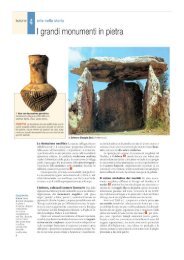



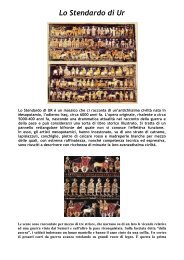
![Kirchner-Munch-Turner-klimt-Fussli - art]è school](https://img.yumpu.com/41667417/1/184x260/kirchner-munch-turner-klimt-fussli-arta-school.jpg?quality=85)

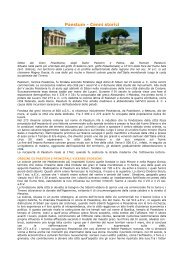
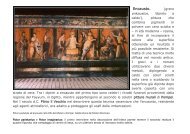

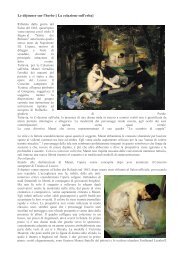
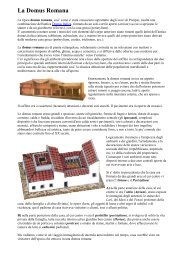
![LA SCUOLA DI BARBIZON Corot, Monet, Sisley e ... - art]è school](https://img.yumpu.com/41547843/1/184x260/la-scuola-di-barbizon-corot-monet-sisley-e-arta-school.jpg?quality=85)
